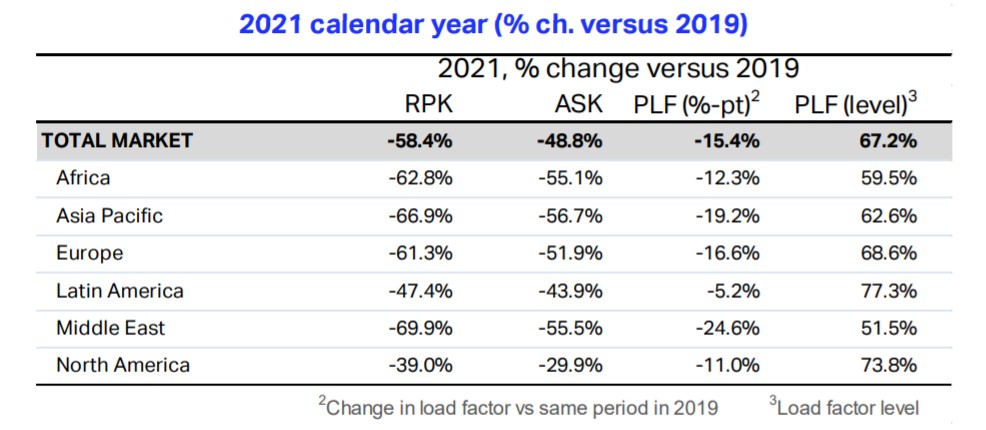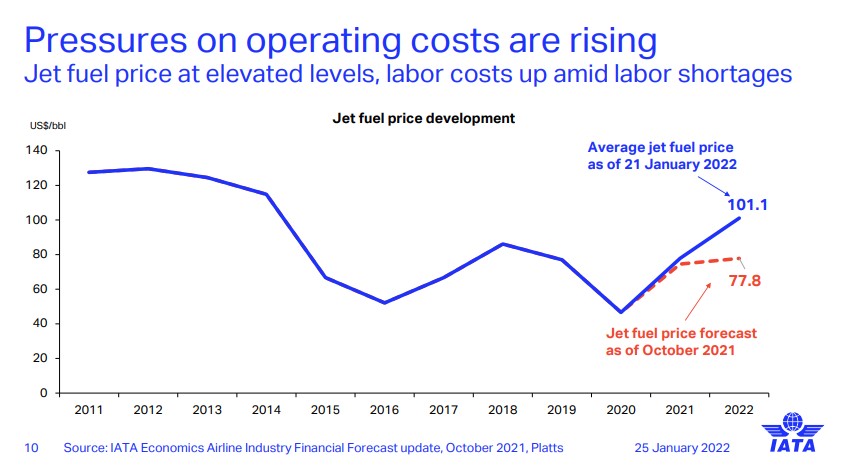IATA: global passenger traffic recovered 42% in 2021 compared to 2019
Global passenger demand recovered by 42% in 2021 versus 2019 figures according to a report presented today by the International Air Transport Association (IATA). This also results in a 58% drop compared to pre-pandemic data, which is a seven percentage point improvement versus 2020, when the retraction was 65.8%.
International traffic continues to be the hardest hit by government restrictions, having plummeted 75.5% during 2021 (in RPK). Capacity meanwhile did so by -65.3% (ASK), resulting in an occupancy factor of 58%, 24 percentage points lower than in 2019.
The domestic segment recorded a 28.2% drop in demand, while capacity fell 19.2% and the occupancy factor fell 9.3 percentage points to 74.3%.

Despite the surge in the omicron variant, the recovery trend continued in December, with demand falling 45.1%, almost two points lower than in November.
«Overall travel demand strengthened in 2021. This trend continued in December, despite travel restrictions in the face of Omicron. That tells you a lot about the strength of passenger confidence and desire to travel. The challenge for 2022 is to reinforce that confidence by normalizing travel. While international travel remains far from normal in many parts of the world, there is momentum in the right direction,» commented Willie Walsh, IATA’s Director-General.
«Last week, France and Switzerland announced a substantial easing of measures. And yesterday the UK removed all testing requirements for vaccinated travelers. We expect others to follow their important lead, particularly in Asia, where several key markets remain virtually isolated,» he added.
Looking at the regional breakdown, North America and Latin America consolidated their position in 2021 as the best performers in the recovery, with declines of 39% and 47.4% respectively.
Capacity (ASK) in Latin American and Caribbean countries was down 43.9%, resulting in just a 5.2 percentage point negative variation in the occupancy factor, which stood at 77.3%, the highest among all regions worldwide, followed by North America at 73.8% and Europe at 68.6%.

Regarding the international segment, Latin American airlines recorded a 66.9% drop in passenger traffic, while capacity fell 62.2%, resulting in an occupancy factor of 72.6% (-10.2 pp), also the highest among the regions.
Another interesting fact also shown in a positive light by Walsh is the similar evolution of the recovery of premium and economy cabins in the international segment.
Although this is not directly related to the improvement in corporate travel (since many passengers travel in premium cabins also on leisure trips), it is nonetheless news that brought optimism.

Walsh called again for governments to «evolve» in their response to COVID-19 and abandon restrictions that «have proven ineffective in preventing the spread of the disease but which inflict enormous damage on people’s lives and economies».
In this regard, the executive showed a graph that shows the poor relationship between the restrictions and the increase in cases.

«A New Year’s resolution for governments should be to focus on building herd immunity and stop placing barriers in the way of a return to normality,» he concluded.
Costs
Walsh also noted that one area of concern is the significant rise in industry costs, especially fuel but also labor.
In October, the price of fuel in January 2022 had been forecast to be around USD 77.8 but today it is at USD 101.1.

Regarding this, Walsh said that the airlines will be watching developments very closely and given what happened in the last two years it is unlikely that most airlines will protect themselves from the price by hedging (buying forward positions), at least not in a significant proportion. Recall that during the first few months of the pandemic oil hit record lows.
Document
iata resultados 2021 reporteYou can watch Willie Walsh’s complete conference on our YouTube channel:
O bien escucharla en Spotify:

/https://aviacionlinecdn.eleco.com.ar/media/2022/01/despegue-pista-boston-generica-estados-unidos.jpg)
Para comentar, debés estar registradoPor favor, iniciá sesión